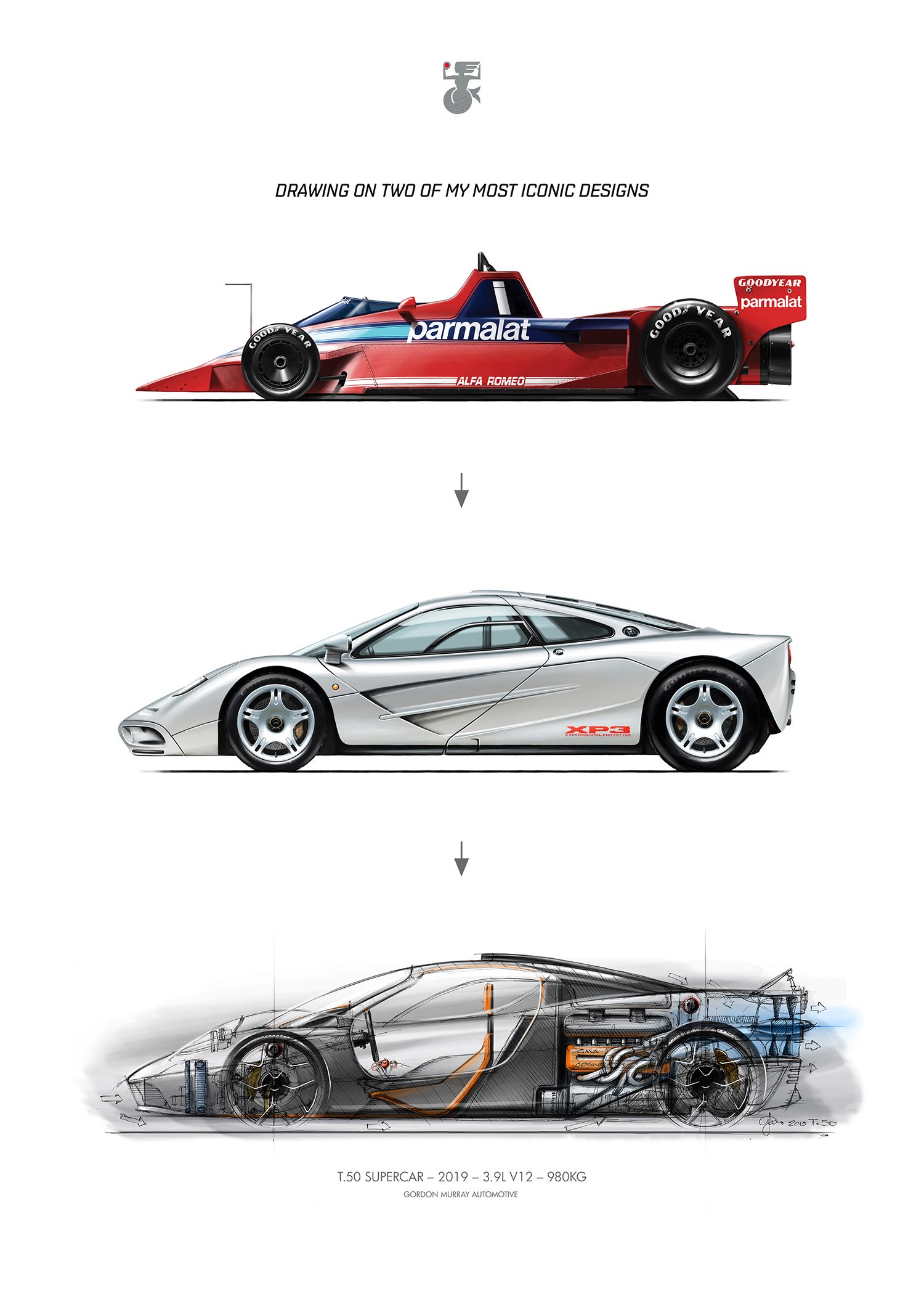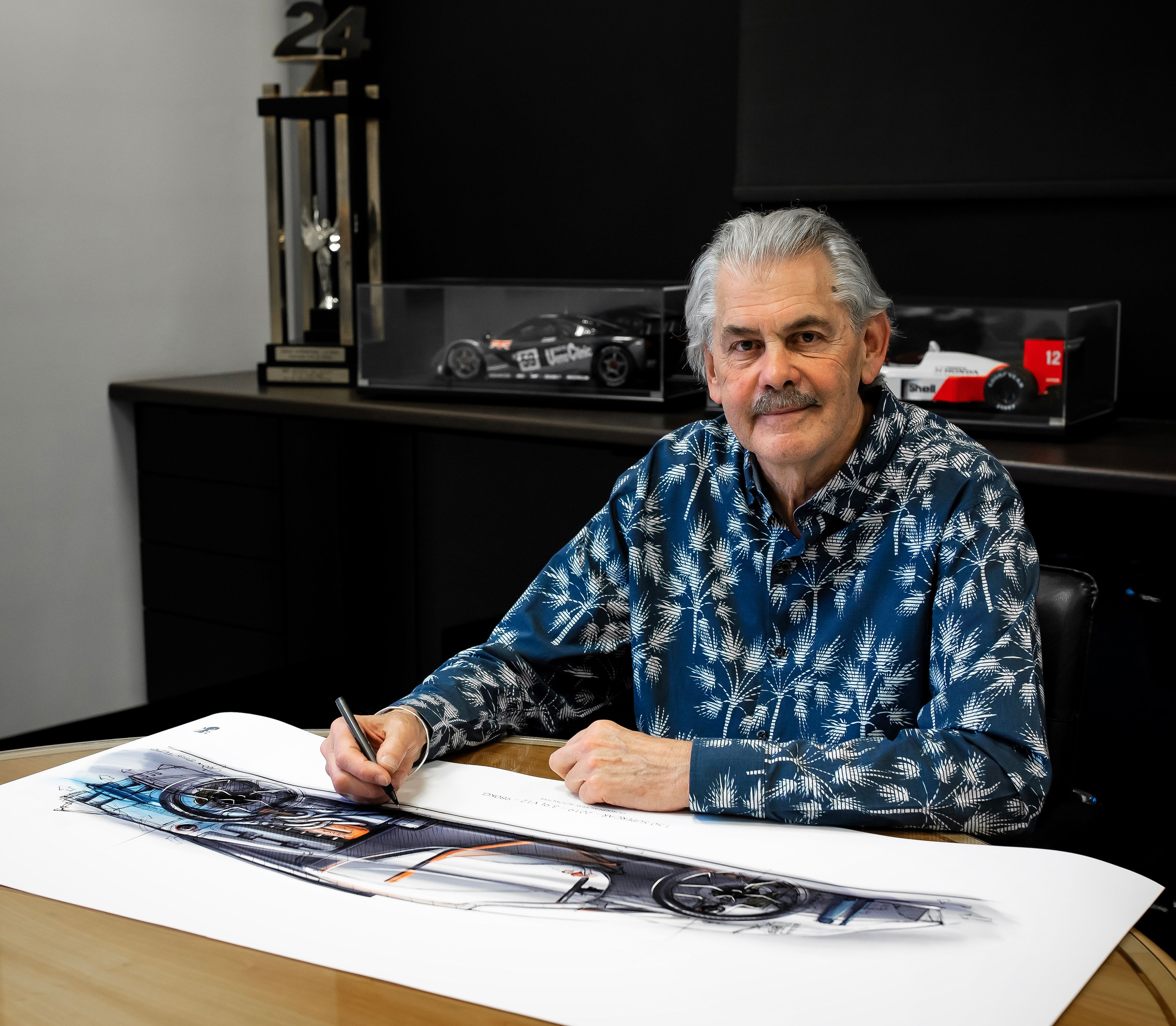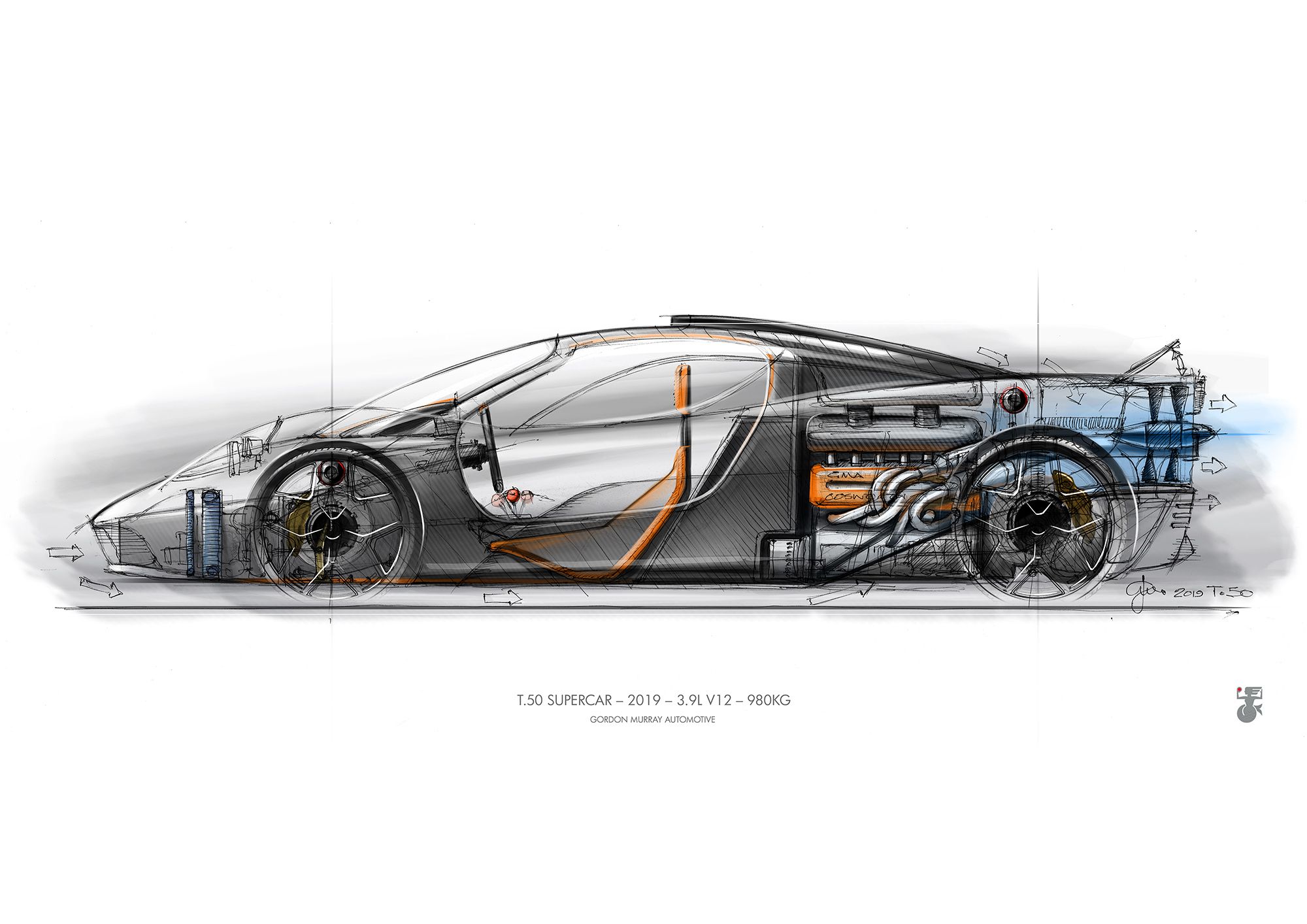Gordon Murray, the British former F1 designer and father of McLaren's first proper road car, is about to be back in the arena of hypercars with a car touted by its creator as being "purest, lightest, most driver-focused supercar ever." Known as the T.50, the hypercar will seat three, like the McLaren F1, and will be powered by a Cosworth-developed 3.9-liter, naturally aspirated V-12 cranking out 650 horsepower and 332 pound-feet of torque. With a 12,100-rpm redline and a $2.46 million MSRP before taxes, it will surely cause a storm when it will finally be unveiled.
What is more, the T.50 is being designed with the intention of going racing as Murray hopes to see it race at Le Mans, although it is unclear if it will compete in the GTE class for production-based supercars or the new-for-2020 'Hypercar' class that will replace the current LMP1 category as the top-tier category of the FIA World Endurance Championship.
When your name is Gordon Murray and you've been in the game of designing some of the world's most daring racing cars and road cars for the better part of four decades, you won't settle for anything short of perfection when building what could be your last road car. After all, as the true spiritual successor to the F1 (with its three seats, its no-nonsense design down to the naturally aspirated V-12, and the clever aerodynamics), the T.50 must be an amazing car or else it will feel like a disappointment to many. And, if, indeed, Murray's team will build a racing version, that too will have to be competitive straight out of the box akin to the F1 that swept the floor in its debut year 24 years ago including a famous outright win in the 24 Hours of Le Mans.
The T.50 Murray is working could make for a formidable race car
Gordon Murray could enjoy his retirement as one of the most revered designers of the modern era having found success in both the realms of motorsports and road car production. He laid out the basis for what would be one of the most dominant F1 car ever, McLaren's Honda-powered MP4/4 that Ayrton Senna and Alain Prost drove to victory lane in all but one of the races of the 1988 World Championship. He also designed, taking inspiration from the American Jim Hall, the Brabham BT46B a decade earlier, a Formula 1 car featuring a fan in the back meant to suck air from under the car to create downforce via ground effects.
We talked about the T.43 and its prolonged gestation period - Murray first talked about his plans to build a budget sports car almost three years ago - before and we think that the wait is worth it as Murray says it'll fill an empty niche. The Briton likened the upcoming T.43 to "a Lotus Elise, but usable every day," one complete with all the creature comforts your heart desires including "air-conditioning that works, sound system, sat-nav, and airbags."
The T.43 is supposed to be powered by a "215 horsepower" Ford-sourced engine and we think that could be Ford's EcoBoost 1.5-liter, three-cylinder mill you'll find in the seventh-generation Fiesta ST as that one cranks out 200 horsepower and 210 torques. This would make it less powerful than Murray's daily, an Alpine A110 which Murray says would've been perfect had it been narrower and lighter (the T.43 is apparently going to tip the scales at under 1,850 pounds, its low weight being the reason behind the usage of such a small powerplant).
So, what can get us more pumped than a reasonably priced 200+ horsepower from Gordon Murray that may make its way Stateside? The T.43's big brother. With a bespoke Cosworth V-12 engine that revs to 12,100 rpm to deliver 650 horsepower, it should be something special. While you can argue that, indeed, the T.50 is a hypercar that offers 11 horsepower less than a run-of-the-mill 488 GTB, Ferrari's now-retired entry-level supercar, you mustn't forget that Murray's emphasis is on lightness, not raw power.
And, after all, you don't need that much oomph to go really fast. The road-going F1 reached 231 mph at Ehra-Lessien in the hands of Andy Wallace and the BMW S70/2 6.1-liter V-12 put out under 620 horsepower in road trim. What is more, Murray says the T.50 will be a sub-2,200-pound car. For comparison's sake, let's just say an F1 weighs little over 2,500 pounds. "Nowadays, when somebody announces a new supercar, and it’s 3,300 pounds, they get applauded, which I find unbelievable," Murray said when talking about the issue of weight surrounding modern supercars.
This can be seen from the outside too as the T.50 will be quite small measuring just 172.4 inches in length, and it will be just 72.8 inches wide or as wide as a 992-generation 911 and over six inches shorter than the Bugatti Chiron. In spite of the diminutive size, the T.50 will seat three in full comfort and will offer "ample storage space". The driver, seated in the middle, will operate an H-pattern XTrac six-speed manual gearbox that sends all of the ponies to the rear wheels. The suspension hanging from the carbon fiber monocoque features double wishbones at all four corners and then there's the fan in the back that helps direct the air through the underfloor venturis to create downforce.
Because of that, Murray reckons the T.50 "will deliver performance and dynamic characteristics simply out of reach for other supercars," and thus become "the last, and the greatest, ‘analog’ supercar ever built," one that will "better the F1 in every area – ingress and egress; luggage capacity; serviceability; maintenance and suspension setup." This may seem boastful coming from anyone but Murray himself.
While we don't know any details about the racing version of the T.50, we can be sure of a few things based on his announcement made during a Motor Sport Magazine-organized 'Game Changers' event. For starters, the fan will be out of the picture as it's an active aero component and those are outlawed from the outset. This will, of course, see Murray's team go back to the drawing board and do a bit (more) of redesigning as we guess the road car's entire philosophy is based around heaving the fan to create ground effects by sucking out the air from under the car. Without that, you need something that Murray tried to avoid: a traditional aerodynamic package featuring a large wing, a widened floor with winglets and dive planes and, also, a reshaped splitter and diffuser.
On top of all that, the team at IGM will have to extract a bit more power from the 3.9-liter Cosworth-GMA V-12 naturally-aspirated engine as you're allowed with engines producing as much as 750 horsepower and you can either get to that number by means of a hybrid drivetrain or, simply, with a beefy engine. We think Murray won't get busy with a hybrid system, mainly because of the added weight, so we think a race-spec Cosworth V-12 will be even more powerful than that on the road car. This is in no way shape or form far-fetched as the race-spec S70/2 put out around 680 horsepower at 7,800 rpm unhinged in the middle of the F1 LM. What's interesting, going back to the topic of weight, is that the road-going T.50 is actually underweight with the FIA and ACO imposing a minimum weight for the 'Hypercars' that will replace P1 machinery of 2,425 pounds, almost 300 pounds more than the dry weight of the T.50.
All of the development will require quite some funding but, with Murray planning to make 100 T.50s, if all were to sell, the company would have some change left (considering that it's not cheap to make a T.50 in the first place) to pour into the FIA World Endurance Championship contender. We expect to see the T.50 out on track no earlier than 2022 when the third season of the 'Hypercar' era will kick-off.
Can another Murray-designed car win Le Mans?
Will Gordon Murray make it two for two? This is a question many have asked after reading about the designer's plans but the answer really depends on the competition within the top-tier category of the FIA WEC and the way the Balance of Performance will work (or fail to work). In other words, Murray won't be able to trump Toyota, Aston Martin, and whoever might join the freight by the time the T.50 debuts unless there's a right set of circumstances in place, the sort of circumstances that brought about the F1's win all the way back in 1995.
Team Lanzante, who ran car No. 59 under the 'Kokusaki Kaihatsu Racing' banner was led by Paul Lanzante who was new to the game but was aided by race engineer Graham Humphrys (who would go on to win the race with six different manufacturers) and the GTR's Program Manager, Geoff Hazell. There were other F1s on the grid that year, six to be precise, including two entered by David Price's team (one in West colors and another sponsored by Harrod's), but the No. 59 car was the one that received a bit more attention from the factory. That included a much-needed spare V-12 after J.J. Lehto, one of the three drivers meant to pilot the F1, the others being Masanori Sekyia and Yannick Dalmas, over-revved the engine that was already in the car during qualifying.
In spite of Lehto's engine-breaking best efforts, the fastest McLaren was ninth on the grid behind a host of open-top prototypes (aptly referred to even back then as LMP1 cars as there were some slower ones that were labeled as LMP2s) and some turbocharged F40s that benefitted from extra boost in 'qualy mode'. There weren't any works prototype teams on the grid that year and the pole-sitting WR prototypes powered by Peugeot engines received very little in the way of support from the French automaker, but Courage and Kremer did have some professionals in their cars.
The pair of Porsche-engined Courage C36s were crewed by Mario Andretti/Éric Helary/Bob Wollek and Eric Bernard/Franck Lagorce/Henri Pescarolo, while Kremer’s K8s were in the hands of Christophe Bouchut/Thierry Boutsen/Hans-Joachim Stuck and Antonio Hermann de Azevedo/Franz Konrad/Jurgen Laessig. As the French flag was waived at 03:00 PM local time, the prototypes romped into the distance.
"We just plodded away,” explained Lanzante. “What I wanted to do was bring the car home in one piece. We weren’t racing. Our strategy was to push, but not like crazy. We were very careful with the gearbox; at every stop, we added oil. We saved the car ," added Lanzante quoted by McLaren.
This slowed down the pace of the LMP1 cars and also caused some to fall by the wayside, helping the GT1 contenders to claw back the lost time. All of the McLarens started to go up the leaderboard but, during the night, when thick fog descended upon Circuit de la Sarthe, one driver seemed to have more fun than anyone else: J.J. Lehto.
"J.J. was a bit above all the other drivers," said Lanzante. "There was one moment that blew my mind. I could see on the TV monitor that he was hanging the rear-end out in the wet. I radioed to tell him to take it easy. He was still drifting the car when he replied: ‘I said not to worry. It will be okay.’ I will never forget that. Having him was definitely in our favor." Hazell agreed with Lanzante saying that "He was spinning wheels on the straight shifting gears and was sideways rally-style in the chicanes. I didn’t think we needed to go that fast to win – but it was clear that this car would be a strong contender."
As the sun got back on the sky, McLaren's takeover of the race was complete: Price's two F1s were leading with the Kokusaki Kaihatsu car in third. But, then, the clutch failed on the Thomas Bscher/Jochen Mass/John Nielsen car and this made every McLaren team on pitlane order its drivers to baby the cars even more. On top of that, the rain had ceased falling and the surviving prototypes, chief among which was the Andretti-driven Courage, were back in the hunt.
In the early hours of the morning, "the unexpected zeal of a sponsor called for a change of the rear bodywork to allow his logo to be seen (the bodywork had been dirtied up by the debris and the rain - n.b.). What should have been a simple operation turned into a nightmare when one of the latches, damaged by the earlier accident, was jammed, and its release took 4 minutes," as reported on the ACO's website. In the end, while Wollek was able to get on the same lap with Dalmas, he finished three minutes behind the No. 59 McLaren despite the Ueno Clinic-sponsored car having to stop for a splash-and-dash 30 minutes before the end.
While you can't argue that McLaren's first and, thus far, only win at Le Mans (a GTR long-tail did win its class and finish second overall in 1997 behind a TWR-Porsche WSC-95 prototype) was a lucky one, benefitting from Courage's misfortune, it's also true that the F1 GTR was an amazingly good race car and, most likely, Murray still takes great relish in remembering about that victory and he surely wishes the T.50 can follow suit.
Further reading
Gordon Murray Works On A McLaren F1 Successor Called The T.50
Read our full review on the 1995-1997 McLaren F1 GTR.
Read our full review on the 1997 Gulf McLaren F1 GTR Longtail.
Check out more details on the McLaren F1 GTR ‘25R’ Restoration.
Read our full review on the 1993 McLaren F1.
Read our full review on the 1995 McLaren F1 LM



